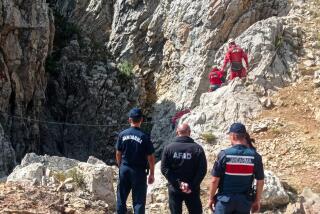SCIENCE : Seeking Funds With a ‘Virtual Dig’ : Archeological Site Has Plans to Go on Internet in Search of Support
- Share via
CATALHOYUK, Turkey — There, far below, are the tightly packed, flat-roofed houses. Swoop down and an entrance can be found--a hole pierced through the ceiling of one home.
Clamber down a ladder and, suddenly, a room comes into view. Along the walls, there are benches lined with cattle horns. The columns are decorated with bulls’ heads. In a central spot, positioned like a shrine, rests a molded relief that may represent the bosomy Anatolian “Mother Goddess.”
Welcome to the way things were, 10,000 years ago, in one of man’s earliest known towns. Besides yielding its historic mysteries, this site is also providing archeologists and enthusiasts with a 21st-Century experience. Call it the Virtual Dig.
As every scrap of information emerges from the huge earthen mound here on the central Turkish plateau, international researchers hope to make it available around the globe through a dazzling array of high technology--including satellite broadcasts, Internet sites and CD-ROMs.
“I suppose the reason for these efforts is a realization that we rely more and more on public funds” to support scientific investigations into such unknowns as what ancient people here ate, with whom they slept and even what they left on a floor that they presumed they had swept clean, said Dr. Orrin Shane of the Science Museum of Minnesota. “We are worried that if there is no pay-back, we’ll lose the funding.”
The Catalhoyuk excavation, on which a team of 50 experts from around the globe are laboring, already updates its progress with words and pictures available to computer enthusiasts with access to the World Wide Web. Shane is trying to organize a satellite broadcast of the digging work.
Germany’s Karlsruhe Academy of Fine Arts is working on a CD-ROM and testing “virtual reality” technology to let Internet users anywhere in the world ramble through a reconstruction of Catalhoyuk.
‘We are collecting all the 3-D images we can. Each visitor will be able to move around freely in the ‘virtual rooms’ of the ‘virtual museum,’ ” said Prof. Lother Spree, director of the Karlsruhe team, which is also filming seemingly every move by the archeologists, including their decision-making meetings.
*
While the running cost of this excavation may seem small--$80,000 this season--organizers say they need more sponsors and cash for advanced equipment, buildings and a real museum on the site.
Ironically, considering the array of cutting-edge equipment trained on developments here, the most dramatic-looking finds, thus far, have come from 1960s excavations by British archeologist James Mellaart, who discovered this site. With deep-dig methods of his day, he uncovered wall-paintings of bulls and hunters similar to those usually seen in neolithic caves. They included rare scenic depictions of an apparent eruption of a volcano nearby.
Ian Hodder, the new excavation director from Darwin College, Cambridge, plans to go far more slowly with the work now than Mellaart did, extending labors here for 25 years. In the first full season of digging in 1995, archeologists cleared Mellaart’s excavations, which covered only an estimated 4% of the total site.
Hodder also focused on a new area, identified in a magnetic-resonance survey. This zone, tests showed, included buildings whose side walls mysteriously point to the top of the mound, which juts about two dozen yards above the plain.
Crouched over small, shiny metal dustpans, the archeologists on a recent day probed a charred floor in one building. A laser range-finder, linked to a laptop computer, plotted finds of volcanic glass tools, a deer horn, a cattle jawbone and a still-blackened oven. The deepest point after weeks of work was just a foot or so below the top of the mound.
“We need to answer the questions raised by Mellaart’s work. We need a new way to use modern scientific techniques. The whole process is very detailed and slow,” Hodder said.






